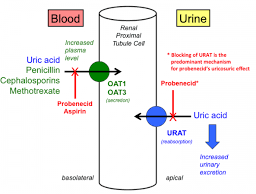The nurse is providing instructions about a client's new medications. How should the nurse explain the purpose of probenecid, a uricosuric drug?
Prevents the formation of kidney stones.
Increases the strength of the urine stream.
Decreases pain and burning during urination
Promotes excretion of uric acid in the urine.
The Correct Answer is D
Choice A rationale: Probenecid does not prevent kidney stones. Its primary function is to increase the excretion of uric acid in the urine.
Choice B rationale: Probenecid does not affect the strength of the urine stream. Its action is specific to uric acid excretion.
Choice C rationale: Probenecid is not used to alleviate pain and burning during urination. Its main indication is for gout and hyperuricemia.
Choice D rationale: Probenecid is a uricosuric drug used to treat gout and hyperuricemia. It works by inhibiting the reabsorption of uric acid in the kidneys, which promotes its excretion in the urine. By increasing uric acid excretion, probenecid helps to reduce the concentration of uric acid in the blood and prevent gout attacks.

Nursing Test Bank
Naxlex Comprehensive Predictor Exams
Related Questions
Correct Answer is ["A","C","E","G"]
Explanation
Choice A rationale: This is essential to ensure that the insulin is not discolored or cloudy, as these changes could indicate a problem with the insulin's stability or effectiveness.
Choice B rationale: While it is essential to have a complete history and physical for proper patient care, double-checking this with another nurse is not necessary in the immediate administration of insulin lispro.
Choice C rationale: Double-checking the dose of insulin in the syringe is crucial to avoid medication errors and ensure that the correct amount is being administered to the patient.
Choice D rationale: The sliding scale order is not mentioned in the information provided, and since it is not part of the immediate insulin administration, it does not need to be double-checked in this context.
Choice E rationale: Checking the expiration date is necessary to ensure that the insulin is still within its usable period. Using expired insulin can lead to reduced potency and potentially ineffective blood sugar control.
Choice F rationale: The information provided in the nurse's notes does not indicate that insulin administration is due at a specific site (e.g., subcutaneous injection). Therefore, there is no need for a second nurse to double-check the site at this moment. However, it's important for the administering nurse to choose the appropriate site following the facility's guidelines and rotate injection sites to prevent lipodystrophy.
Choice G rationale: Different types of insulin come in different concentrations (e.g., U-100, U-200). It's important to confirm that the correct concentration is being used to ensure accurate dosing.
Choice H rationale: The nurse should verify that the insulin to be administered is indeed insulin lispro, as indicated in the medication order. Administering the wrong type of insulin can have significant implications for the patient's blood sugar control.
Correct Answer is C
No explanation
Whether you are a student looking to ace your exams or a practicing nurse seeking to enhance your expertise , our nursing education contents will empower you with the confidence and competence to make a difference in the lives of patients and become a respected leader in the healthcare field.
Visit Naxlex, invest in your future and unlock endless possibilities with our unparalleled nursing education contents today
Report Wrong Answer on the Current Question
Do you disagree with the answer? If yes, what is your expected answer? Explain.
Kindly be descriptive with the issue you are facing.
